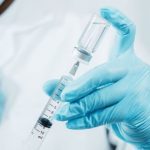 Mysteries
Mysteries  Mysteries
Mysteries  History
History 10 Surprising Stories About the Texas Rangers
 Humans
Humans 10 Philosophers Who Were Driven Mad by Their Own Theories
 Miscellaneous
Miscellaneous 10 Video-Game-Worthy Weapons and Armors from History
 Weird Stuff
Weird Stuff 10 Psychics Who Accurately Predicted Wartime Events
 The Arts
The Arts 10 Pieces of Art Inspired by a Broken Heart
 Health
Health 10 Science Fiction-Sounding New Medical Treatments
 History
History 10 Surprising Facts About the Father of Submarine Warfare
 Space
Space Ten Astonishing New Insights into Alien Worlds
 Weird Stuff
Weird Stuff 10 Bizarre Summer Solstice Rituals Still Practiced Today
 Mysteries
Mysteries Top 10 Haunting Facts About the Ghost Ship MV Alta
 History
History 10 Surprising Stories About the Texas Rangers
 Humans
Humans 10 Philosophers Who Were Driven Mad by Their Own Theories
Who's Behind Listverse?

Jamie Frater
Head Editor
Jamie founded Listverse due to an insatiable desire to share fascinating, obscure, and bizarre facts. He has been a guest speaker on numerous national radio and television stations and is a five time published author.
More About Us Miscellaneous
Miscellaneous 10 Video-Game-Worthy Weapons and Armors from History
 Weird Stuff
Weird Stuff 10 Psychics Who Accurately Predicted Wartime Events
 The Arts
The Arts 10 Pieces of Art Inspired by a Broken Heart
 Health
Health 10 Science Fiction-Sounding New Medical Treatments
 History
History 10 Surprising Facts About the Father of Submarine Warfare
 Space
Space Ten Astonishing New Insights into Alien Worlds
 Weird Stuff
Weird Stuff 10 Bizarre Summer Solstice Rituals Still Practiced Today
10 Un-Be-Reef-Able Medical Breakthroughs Found in the Ocean
Even though oceans have been around for eons, they remain a mystery to humans. Oceans stretch miles across the planet, with many tales about treacherous journeys across the sea. The earth’s oceans are filled with crushing pressures, terrifying predators, and intense currents, making it virtually impossible to fully explore the depths of these dark and mysterious realms.
While these conditions make the ocean uninhabitable for humans, deep sea creatures have been able to adapt and thrive in these dangerous parts. Ocean animals have developed fascinating compounds and chemicals to survive in the ocean’s depths, and these remarkable elements may also be effective in boosting human survival.
So let’s dive in as we unearth some of the most un-be-reef-able medical breakthroughs discovered in the ocean!
Related: Top 10 Disgusting And Unexpected Medical Treatments
10 Snail Venom 1,000 Times More Potent Than Morphine
It sounds a bit silly when people first hear that a species named the Pacific cone snail exists, but don’t let your guard down around these creatures! Smithsonian Magazine states that the Pacific cone snail’s “poisonous harpoon-like stingers can paralyze and kill fish and humans.” A biochemist named Baldomero Olivera decided to think outside the box and theorized that the Pacific cone snail’s venom could provide therapeutic remedies for humans and began extensive research.
Eventually, further snail venom research led to the creation of a drug named Prialt. An Irish pharmaceutical firm found that Prialt “appears to be 1,000 times more potent than morphine” while lacking the addictive and mind-altering side effects. In a Prialt clinical trial, a man suffering from long-term cancer side effects reported that within days of being treated with Prialt, his pain had diminished greatly. With the discovery that Prialt had effective therapeutic benefits, Prialt got FDA approval and is still being utilized worldwide today. [1]
9 Breakthrough AIDS Treatment Found in Sea Sponges
No, these real-life sea sponges don’t live in a pineapple under the sea. Instead, they roam the sea floor. Despite their unassuming appearance, sea sponges contain extremely beneficial biochemical compounds. According to Smithsonian Ocean, organic chemist Werner Bergmann discovered that sea sponges contain powerful chemicals that halt viral infections. From this, the compounds found in sea sponges were used as models for drug breakthroughs. Thus, the groundbreaking HIV drug AZT was discovered!
Michigan Medicine states the source of HIV’s ability to wreak havoc on the body is a protein called Nef. As stated in the article, “HIV uses Nef to avoid blowing its cover and bring the immune system’s swift justice down on its hiding places.” Fortunately, the sea sponge’s bacteria can make substances that can interfere with Nef and stop it from working. Thus, with the approval from the FDA, AZT was able to be distributed during the 1980s and helped to combat the symptoms of many who were suffering from HIV/AIDS.[2]
8 We Can Thank Horseshoe Crabs for Safe Vaccinations
Horseshoe crabs are remarkable underwater creatures. This species seems almost mythological, with over 450 million years of existence and bright blue blood. However, these animals are not only real but also life-saving! According to the Natural History Museum, horseshoe crab blood contains important immune cells that are “exceptionally sensitive to toxic bacteria.” When invading bacteria enter the horseshoe crab, these cells clot around the invaders and protect the rest of the crab’s body from toxins.
From this discovery, scientists formulated a test for new vaccines to identify and remove contaminants. Since the 1970s, this technique has allowed medical practitioners to deliver safe vaccines rather than syringes full of bad bacteria that could make humans very sick. With the benefits horseshoe crabs have contributed to vaccine development, further research on horseshoe crabs may aid in new vaccine advances in the future.[3]
7 Marine Worm Blood May Help with Blood Transfusions
Worms, while not exciting, have been found to have fascinating properties. The National Library of Medicine published a study showing that the hemoglobin derived from marine worms’ red blood cells is “an efficient therapeutic O2 carrier with potential anti-inflammatory, anti-bacterial, and antioxidant properties.” It may also play a role in helping doctors preserve organs. Thus, these properties could start being used to aid in blood transfusions.
With blood donations in short supply, humans began testing animal blood transfusions; unfortunately, animal blood can cause allergic reactions or damage to the kidneys. However, marine worm blood provided a much different result, not showing any of these effects. Additionally, human blood transfusions bear the risk of clogging kidney filtration systems, while marine worm proteins have a very low risk of having this effect. With their promising benefits, scientists agree that marine worms are worth further research![4]
6 Common Ocean Bacteria Can Disrupt Cancer Cell Growth
While hard to pronounce, cyanobacteria is an easy-to-find bacteria in the ocean. While these creatures are microscopic, they contain amazing elements that allow them to survive in harsh conditions. One remarkable compound produced by cyanobacteria, named gatorbulin-1, was reported on in an Ocean Smithsonian Institute article, stating that gatorbulin-1 “interferes with cell division by hindering the cell machinery that carries out the duplicating process.”
Cancer cells’ ability to multiply rapidly is detrimental to the human body; therefore, having a compound that can halt the duplication process is a large milestone for scientists. Dolastatin 10, another compound found in marine cyanobacteria, served as the blueprint for the development of three FDA-approved drugs for various lymphomas and refractory bladder cancer. Like gatorbulin-1, it disrupts the formation of microtubules. The findings from cyanobacteria have made waves in the medical community; thus, scientists continue to dive deep underwater to find out more.[5]
5 Starfish May Be Able to Combat Inflammatory Diseases
While the common starfish isn’t likely to befriend sea sponges like in Spongebob Squarepants, the two species offer many medical benefits. A BBC News article states that starfish may be the missing link to finding a “new treatment for inflammatory conditions such as asthma, hay fever, and arthritis.” This is due to the starfish’s ability to keep their surfaces clear, with nothing sticking on the animal, while man-made structures become covered with marine life. Starfish can avoid other creatures sticking to them because of the “slimy goo” that covers their bodies.
Scientists thus theorized that this aspect of starfish survival may be able to treat inflammation, which occurs when white blood cells stick to the blood vessel wall and build up, damaging body tissues. Scientists believe that coating our blood vessels in some substance, much like the starfish uses this goo, could prevent this problem. By using the starfish as a model, scientists are looking to create treatments inspired by starfish “slimy goo.” With more time, starfish research may provide accessible treatments for inflammatory diseases such as arthritis and asthma.[3]
4 Sea Squirts: Cute Name & Mind-Blowing Anti-Cancer Benefits
Cancer is a serious disease that is difficult to cure; therefore, scientists are determined to find ways to combat cancerous tumors. Fortunately, animals called sea squirts may be able to provide effective anti-tumor capabilities. Harvard University researchers found that sack-like sea squirts living on the sea floor make a complex anti-tumor drug hundreds to thousands of times more powerful than any cancer potion now in use. This exponential increase in potency was groundbreaking in cancer research.
Eventually, a drug called ecteinascidin was created to provide chemotherapy to cancer patients. Unfortunately, the drug required laborious efforts and needed a high volume of sea squirts. In fact, ten pounds (4.5 kilograms) of sea squirts yielded only millionths of an ounce of ecteinascidin. Thus, when post-doctorate fellow David Gin found a way to make the drug synthetically, ecteinascidin took off.
After long-term analysis, it was found that ecteinascidin, also named trabectidin, was “associated with high rates of survival and clinical benefit rate for patients with advanced high-grade soft tissue sarcomas.” The fact that a species called the sea squirt can provide chemotherapy to humans is a reminder not to judge a book by its cover![7]
3 Phytoplankton Can Fight off Muscle Damage
With the mention of sponges, crabs, and starfish, we couldn’t help ourselves from mentioning plankton, too! Researchers found that phytoplankton, tiny deep-sea algae that float in the ocean, are rich in antioxidants that could help sustain performance and lower muscle damage. A study published in the National Library of Medicine tested participants divided into two groups. One group was given phytoplankton supplements, while the other was given a placebo. Then, both groups underwent a strenuous cross-training event.
Researchers found that the placebo group showed greater muscle damage than those given the phytoplankton supplements. Therefore, researchers concluded that because phytoplankton supplements “operate through an elevating oxidative capacity in skeletal muscle,” the participants receiving the supplements were “able to improve recovery, sustain power, and prevent declines in strength across repeated endurance and cross-training bouts.” With further research, athletes competing in high-stress environments may soon have access to improved strength and recovery.[8]
2 Moss-Like Sea Creatures May Be Hiding Anti-Cancer Compounds
The Bugula neritina species have been dubbed pests best known for fouling up marine environments. However, this bryozoan animal is hiding a remarkable power inside its bacteria. Bryostatin 1 is a substance that “binds to and inhibits cell-signalizing enzyme protein,” which can stop rapid cell growth and encourage the death of cancer cells. Researchers at the Scripps Institution of Oceanography discovered that the anticancer drug Bryostatin 1 can be extracted from colonies of Bugula neritina.
Although extracting bryostatin from Bugula neritina proved difficult to collect without harming the environment, the animals could serve as research models for more efficient bryostatin production. After decades of testing, Stanford researchers discovered a production method that was tens of thousands of times more efficient than extracting bryostatin from B. neritina. With clinical trials showing promise, Bryostatin 1 is on its way to treating cancer, Alzheimer’s disease, and strokes![9]
1 A World of Possibilities in Our Oceans
With the constant evolution and resistance of diseases in today’s day and age, it’s important to continue searching for new, effective medical treatments. A study published by the National Library of Medicine states that the ocean has “more than 13,000 molecules described out of which 3,000 are having active properties,” which indicates the plethora of medical breakthroughs still hiding underwater.
However, it’s important to continue to keep ocean ecosystems pristine. As stated in a National Oceanic and Atmospheric Administration video, “The ocean may hold the key for finding new medicines, but not if we don’t keep it—and everything that lives there—healthy and pollution free.” So treat the ocean with respect—if the ocean is thriving, human survival may also thrive![10]








